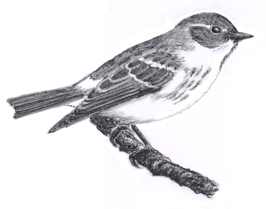
Dear Bird Folks:
We have a bird that I’m pretty sure is a warbler coming to our suet feeder. The bird is mostly dull brown, with a bit of yellow on its side, a bright yellow spot on its tail, plus a weird single feather sticking out of its back. I’m thinking it is a yellow-rumped warbler, but aren’t warblers birds of summer? And what is with that odd feather coming out of its back?
-Adam, -N. Falmouth
Very Good Adam,
that was a very good description of what is indeed a Yellow-rumped Warbler. Although the bird has to be embarrassed about its name, especially during its high school years, yellow-rumped is a very good descriptive name. I wish more birds had such an easy field mark, with a corresponding name to match. Forget about that weird feather, it is not normally part of the bird. If it doesn’t fall out soon, that odd feather will be gone as soon as the spring molt begins. Your warbler was probably having a bad hair day or a case of nest-head or simply a “wardrobe malfunction”.
Any of us who were born before the golden age of disco, may remember that the Yellow-rumped Warbler used to be called the “Myrtle” Warbler. Like a lot of things, that all changed in the early ’70’s when the birding gurus decided that our eastern Myrtle Warbler and the western “Audubon” Warbler were the same species. Now both birds are collectively called Yellow-rumped Warbler. Many of us weren’t happy with the name change, but who can fight the awesome power of the birding gurus? Not me.
The reason why these birds were called Myrtle Warblers in the first place is because they eat and actually seem to enjoy the smelly waxy berries of the wax myrtle bush. Wax myrtle is much like our bayberries, which yellow-rumps also like to eat.
While early Cape Codders were all proud of themselves for figuring out how to turn the wax from bayberries into candles, yellow-rumps had long been able to turn these berries into a life saving meal. Wax is not readily digested by most creatures but yellow-rumps have evolved an enzyme that apparently enables them to turn the wax into nourishment.
February in New England is no place for any insect loving bird like a warbler. Most warblers have long since migrated to the tropics, where bugs are never in short supply. It is the yellow-rump’s ability to feed on berries that allows it to remain in the north and avoid the long and dangerous migration. In addition to bayberries, yellow-rumps also eat the berries of junipers, Virginia Creeper and poison ivy, which could help explain their constant scratching.
Yellow-rumped Warblers are one of our most abundant wood warblers, often seen in the thousands on migration. Their abundance is related to their adaptability. In nature, most creatures have evolved to exploit various niches. Each species of warbler seems to have its own niche. Some warblers feed only at the tops of trees, while others hunt for food on the inner branches and still other warblers hunt for food along the ground. Yellow-rumps have no use for any of that segregation. Like the neighbor’s unleashed dog, they eat anywhere there is food. They have developed the skills to find food in just about every level of the ecosystem. They will also sally out to pick insects out of the air like a flycatcher or scoop them out of the water like a swallow. In a totally unwarbler-like move, yellow-rumps have been known to sip the sap dripping out of trees like a sapsucker. And as you already know, Yellow-rumps are one of the few warblers that will visit our feeders. They readily come to suet.
You are right Adam, in this part of the world, late spring is the time for warbler sightings. But as we have written about several times before, finding food is the key to any bird’s survival. When it comes to finding food, this warbler is a master. You know a bird is tough when it can make a meal out of eating waxed fruit. It’s important to remember that wax berries should only be eaten in the cold weather. If they eat the wax in the summer, the heat makes the birds soft and droopy. And nobody likes a droopy yellow rump.